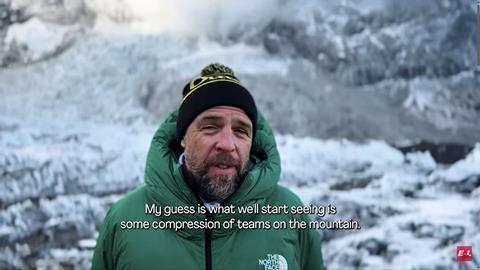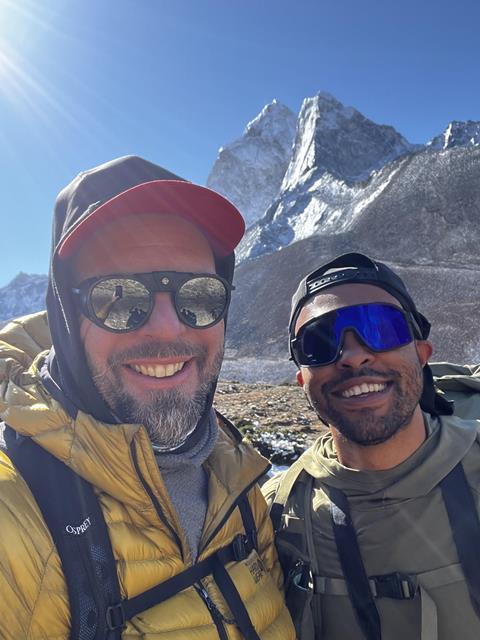Ben Ayers, co-founder at Rainshadow Films brought sport broadcasting techniques to the world’s highest peak

On May 15, 2025, I stood at Mt. Everest Base Camp, 5,364 meters above sea level on the Khumbu Glacier. Bundled in a heavy down parka and dark mountaineering sunglasses, I prepared to film my daily dispatch. My colleague, Charlie Rollins, adjusted the camera. This report carried special weight: the night before had marked the season’s first death of a foreign climber. After months of planning and an 11-day high-altitude trek, our scrappy two-person team had overcome countless obstacles—building an audience from scratch, keeping camera batteries charged in the bitter cold, and battling sluggish satellite internet to send high-quality videos just minutes after filming. But Everest has its own rhythm and rules. As the camera rolled, I opened my mouth to speak—only to discover that my voice was completely gone.
I created Everest.Live with my business partner, Andrew Lynch, with whom I run Rainshadow Films, a boutique production company based in London. We saw an opportunity to tap into the world’s enduring fascination with Mt. Everest and the real-life drama that unfolds each climbing season on the world’s highest peak. I’m a mountaineering journalist and humanitarian who has lived in Nepal for over two decades, with deep knowledge and trusted relationships on the mountain. Andrew contributed a decade of experience in live sports production, including work for the Olympic Games, FIFA World Cup, and other major global events.
I knew that we could do some incredible storytelling at Mt. Everest. It’s a household name across the world, and it’s one of the most iconic sports brands on the planet. But it wasn’t going to be easy.
To secure permission to stay at Base Camp for the entire season, we signed up for an expedition, knowing we had no intention of summiting. Instead, we set up a micro-production hub in a tent, self-shooting and producing all content on-site. Footage was sent to Andrew in London, who polished and published the content, often within an hour of filming.
The collaboration worked really well. Andrew could take raw footage from Everest and elevate it to a high production standard, while still posting during peak viewing hours in the UK and US.
Our content followed a live sports model, with a predictable editorial cadence. Daily dispatches served as highlights, providing updates on climbers’ progress and dramatic events on the mountain. Character-driven features profiled both Sherpa heroes and well-known mountaineers, offering behind-the-scenes insight into the Everest climbing industry. Summit countdowns and expedition updates built tension and boosted audience engagement.
The first season ran across TikTok, YouTube, and Instagram, with tailored content for different demographic groups. Every effort was made to respond to viewer comments in real time from Base Camp, creating a dynamic feedback loop that informed the next day’s content and built strong audience loyalty.
Over 35 consecutive days, Everest.Live relied entirely on organic growth. By the end of the season, the project had amassed more than 10 million views and exceptionally high engagement. Our team is now preparing for 2026 with plans to scale through brand partnerships. A video podcast is also in development to maintain momentum during the off-season.
As Andrew told me, “2025 was our proof-of-concept year. The audience growth and engagement exceeded expectations. Now it’s time to properly resource the platform and bring it fully to life. With more climbers on Everest each year, next season is shaping up to be even more exciting.
“With the right partners, we can build something incredibly valuable. Everest has all the best elements of sport—clear goals, inspiring characters, constant drama—plus the real-world stakes of life and death. That’s powerful storytelling.”

Ben Ayers (left) is co-founder of Rainshadow Films, and worked with Charlie Rollins (right) on the Everest.Live broadcast





No comments yet